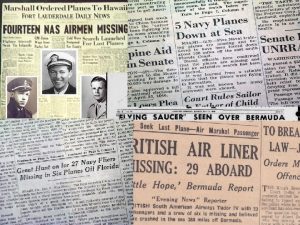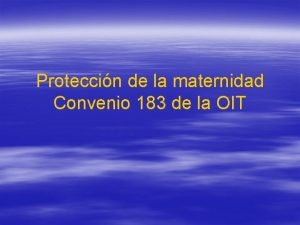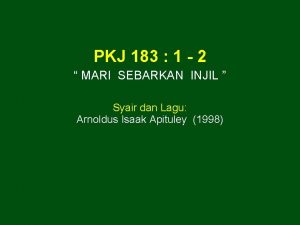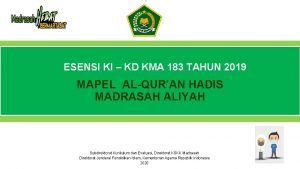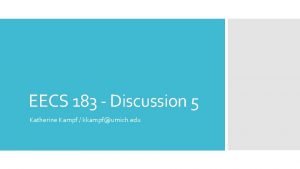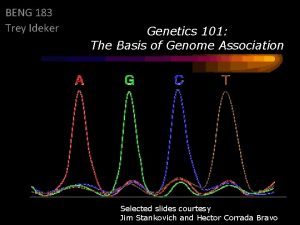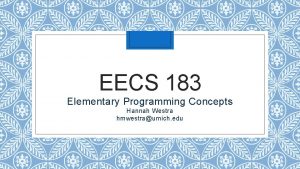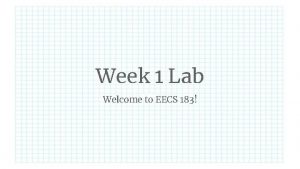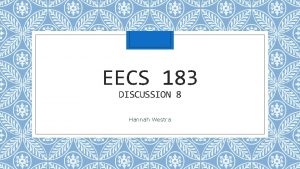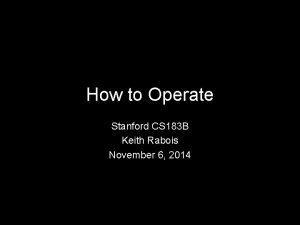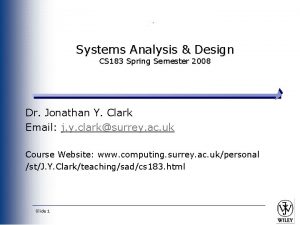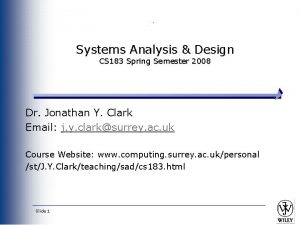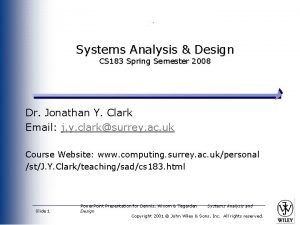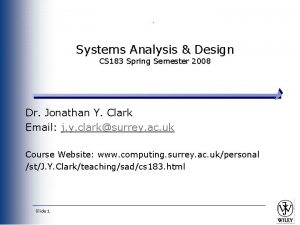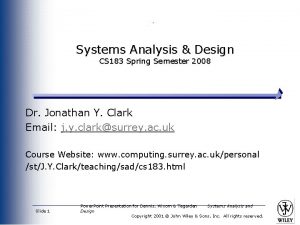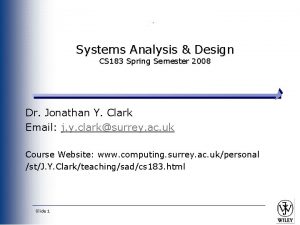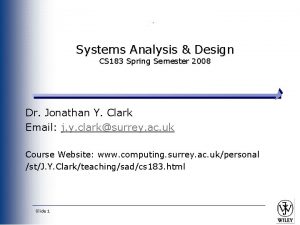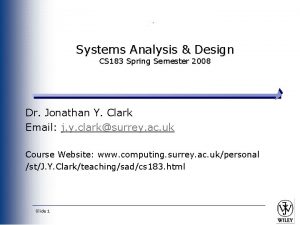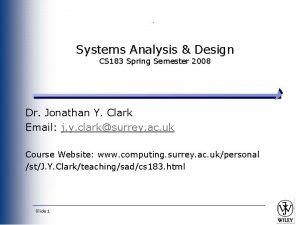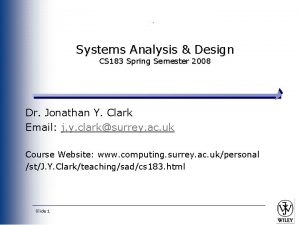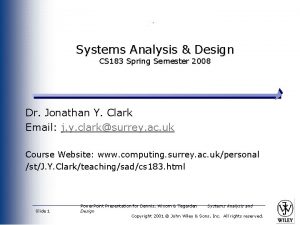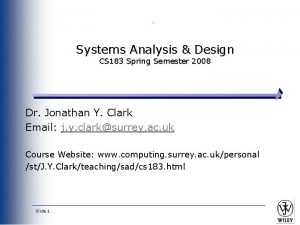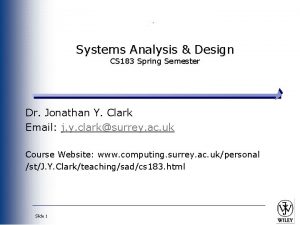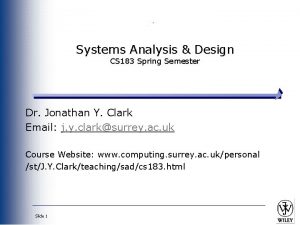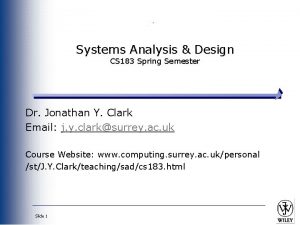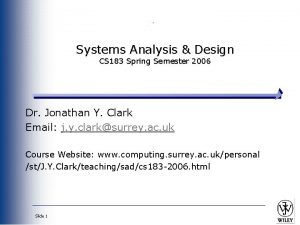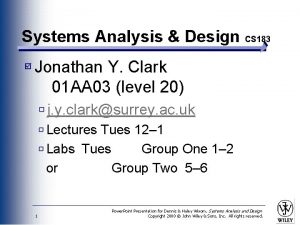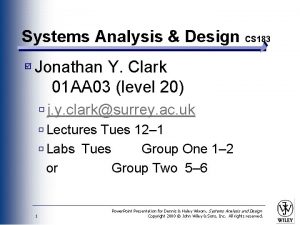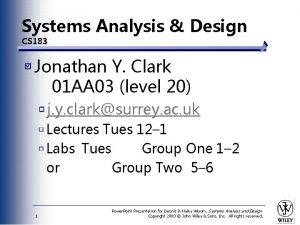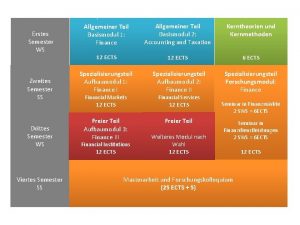Systems Analysis Design CS 183 Spring Semester 2008


































- Slides: 34

Systems Analysis & Design CS 183 Spring Semester 2008 Dr. Jonathan Y. Clark Email: j. y. clark@surrey. ac. uk Course Website: www. computing. surrey. ac. uk/personal /st/J. Y. Clark/teaching/sad/cs 183. html Slide 1

Course Textbook: Systems Analysis and Design With UML 2. 0 An Object-Oriented Approach, Second Edition Chapter 5: Requirements Determination Slide 2

Adapted from slides © 2005 John Wiley & Sons, Inc. Slide 3

SDLC PHASES PLANNING PHASE ANALYSIS PHASE DESIGN PHASE IMPLEMENTATION PHASE Slide 4

Analysis Phase: Key Ideas The goal of the analysis phase is to truly understand the requirements of the new system and develop a system that addresses them. The first challenge is finding the right people to participate. The second challenge is collecting and integrating the information Slide 5

Requirements Gathering Methods 1. 2. 3. 4. 5. Interviews JAD Sessions Questionnaires Document Analysis Observation Slide 6

1. INTERVIEWS Slide 7

Interviews -- Five Basic Steps 1. 2. 3. 4. 5. Selecting interviewees Designing interview questions Preparing for the interview Conducting the interview Post-interview follow-up Slide 8

Selecting Interviewees Based on information needed Often good to get different perspectives Managers Users Ideally, all key stakeholders Slide 9

Types of Questions Closed-Ended Questions Examples * * * Open-Ended Questions * * * Probing Questions Slide 10 * * * How many telephone orders are received per day? How do customers place orders? What additional information would you like the new system to provide? What do you think about the current system? What are some of the problems you face on a daily basis? How do you decide what types of marketing campaign to run? Why? Can you give me an example? Can you explain that in a bit more detail?

Designing Interview Questions Unstructured interview Broad, roughly defined information Structured interview More specific information Slide 11

Questioning Strategies EXAMPLES? High Level Very General TOP DOWN Medium-Level Moderately Specific Low-Level Very Specific Slide 12 BOTTOM UP

Interview Preparation Steps Prepare general interview plan List of questions Anticipated answers and follow-ups Confirm areas of knowledge Set priorities in case of time shortage Prepare the interviewee Inform them of the schedule Tell interviewees reason for interview Inform them of areas of discussion Slide 13

Conducting the Interview Appear professional and unbiased Record all information Check on organizational policy regarding tape recording Be sure you understand all issues and terms Separate facts from opinions Give interviewee time to ask questions Be sure to thank the interviewee End on time Slide 14

Conducting the Interview Practical Tips Don’t worry, be friendly Pay attention Summarize key points Be succinct (concise) Be honest Watch body language Slide 15

Post-Interview Follow-Up Prepare interview notes Prepare interview report Look for gaps and new questions Slide 16

Interview Report INTERVIEW REPORT Interview notes approved by: ______ Person interviewed Interviewer Date Primary Purpose: Summary of Interview: Open Items: Detailed Notes: Slide 17 _______________

2. JOINT APPLICATION DESIGN (JAD) SESSIONS Slide 18

JAD Key Ideas Allows project managers, users, and developers to work together May reduce scope creep by 50% Avoids requirements being too specific or too vague Slide 19

Joint Application Design (JAD) Important Roles Facilitator ensures sticking to agenda helps understanding of technical terms and jargon records group input on clearly-viewable display area Scribe (or scribes) takes minutes and notes makes copies where necessary Slide 20

Joint Application Design (JAD) Setting U-Shaped seating Away from distractions Whiteboard/flip chart Prototyping tools e-JAD Slide 21

JAD Meeting Room JPEG Figure 5 -5 Goes Here Slide 22

The JAD Session Tend to last 5 to 10 days over a three week period Prepare questions as with interviews Formal agenda and groundrules Facilitator activities Keep session on track Help with technical terms and jargon Record group input Help resolve issues Post-session follow-up Slide 23

JAD Sessions -- Five Basic Steps 1. 2. 3. 4. 5. Selecting participants Designing the JAD Session Preparing for the JAD Session Conducting the JAD Session Post-JAD follow-up Slide 24

Managing Problems in JAD Sessions Reducing domination Encouraging non-contributors Side discussions Agenda merry-go-round Violent agreement Unresolved conflict True conflict Use humour Slide 25

3. QUESTIONNAIRES Slide 26

Questionnaire Steps Selecting participants Using samples of the population Designing the questionnaire Careful question selection Administering the questionnaire Working to get good response rate Questionnaire follow-up Send results to participants Slide 27

Good Questionnaire Design Begin with non-threatening and interesting questions Group items into logically coherent sections Do not put important items at the very end of the questionnaire Do not crowd a page with too many items Avoid abbreviations Avoid biased or suggestive items or terms Number questions to avoid confusion Pretest the questionnaire to identify confusing questions Provide anonymity to respondents Slide 28

4. DOCUMENT ANALYSIS Slide 29

Document Analysis Provides clues about existing “as-is” system Typical documents Forms Reports Policy manuals Look for user additions to forms Look for unused form elements Slide 30

5. OBSERVATION Slide 31

Observation Checks validity of information gathered other ways Users/managers often don’t remember everything they do ! Behaviours change when people are watched ! Careful not to ignore periodic activities Weekly … Monthly … Annual ! Slide 32

Selecting the Appropriate Techniques Interviews JAD Type of Information As-Is Improve. To-Be Depth of Information High Breadth of Information Low Integration of Info. Low Questionnaires Observation As-Is Medium Low Medium High Low Low User Medium Involvement High Low Low Cost Low. Medium Slide 33 Medium As-Is Improve. To-Be Document Analysis Low Low. Medium

Summary There are five major information gathering techniques that all systems analysts must be able to use: Interviews, JAD, Questionnaires, Document Analysis, and Observation. Systems analysts must also know how and when to use each as well as how to combine methods. Slide 34
 2008 2008
2008 2008 Spring, summer, fall, winter... and spring cast
Spring, summer, fall, winter... and spring cast Months for spring summer fall winter
Months for spring summer fall winter Where is bermuda
Where is bermuda Convenio 183 oit
Convenio 183 oit Lagu pkj 183
Lagu pkj 183 Ki kd kma no. 183 tahun 2019 (word) ma
Ki kd kma no. 183 tahun 2019 (word) ma Katherine kampf
Katherine kampf Convenção 183 oit
Convenção 183 oit Beng 183
Beng 183 Umich eecs 183
Umich eecs 183 Eecs 183 lab 8
Eecs 183 lab 8 Eecs 183
Eecs 183 Cs 183
Cs 183 Gül kerman
Gül kerman Spring information systems
Spring information systems Systems analysis & design in an age of options
Systems analysis & design in an age of options System analysis and design
System analysis and design Systems analysis and design in a changing world
Systems analysis and design in a changing world Systems analysis and design in a changing world
Systems analysis and design in a changing world System analysis and design alan dennis
System analysis and design alan dennis System analysis and design
System analysis and design Ssadm model
Ssadm model Modern system analysis and design
Modern system analysis and design Modern systems analysis and design
Modern systems analysis and design Kendall and kendall system analysis and design
Kendall and kendall system analysis and design System analysis and design dennis
System analysis and design dennis Systems analysis and design alan dennis
Systems analysis and design alan dennis Systems analysis and design alan dennis
Systems analysis and design alan dennis Systems analysis and design alan dennis
Systems analysis and design alan dennis Systems analysis and design alan dennis
Systems analysis and design alan dennis Systems analysis and design alan dennis
Systems analysis and design alan dennis Systems analysis and design alan dennis
Systems analysis and design alan dennis Ssadm diagram
Ssadm diagram Radar systems analysis and design using matlab
Radar systems analysis and design using matlab



